Abstract
Anaerobic bacteria predominate in the normal human fecal flora, out-numbering aerobes at least 100 to one. The two most prevalent organisms are Bacteroides fragilis and Bifidobacterium. Ileostomy flora is, on the other hand, chiefly aerobic and the total count is lower (108 per ml of fluid, compared to 1010 per gram for feces). In normal people, small bowel bacterial counts are generally 105 per ml or less. The upper small bowel consists primarily of Gram-positive aerobes in small numbers. In the terminal ileum, counts are higher and aerobes and anaerobes are present in equal numbers. In the presence of acute obstruction and certain bowel stasis or other syndromes, the small bowel flora may become relatively profuse and fecal in type. The stomach normally has less than 103 organisms per ml but counts are higher in gastric samples with pH above 4.0.
Intestinal bacteria are important in such processes as conversion of bilirubin to urobilinogen, supply of vitamin K to the host, defense against infection, bile acid deconjugation and conversion, infections related to the bowel, the malabsorption of blind loop and other bacterial overgrowth syndromes, and hepatic coma.
Full text
PDF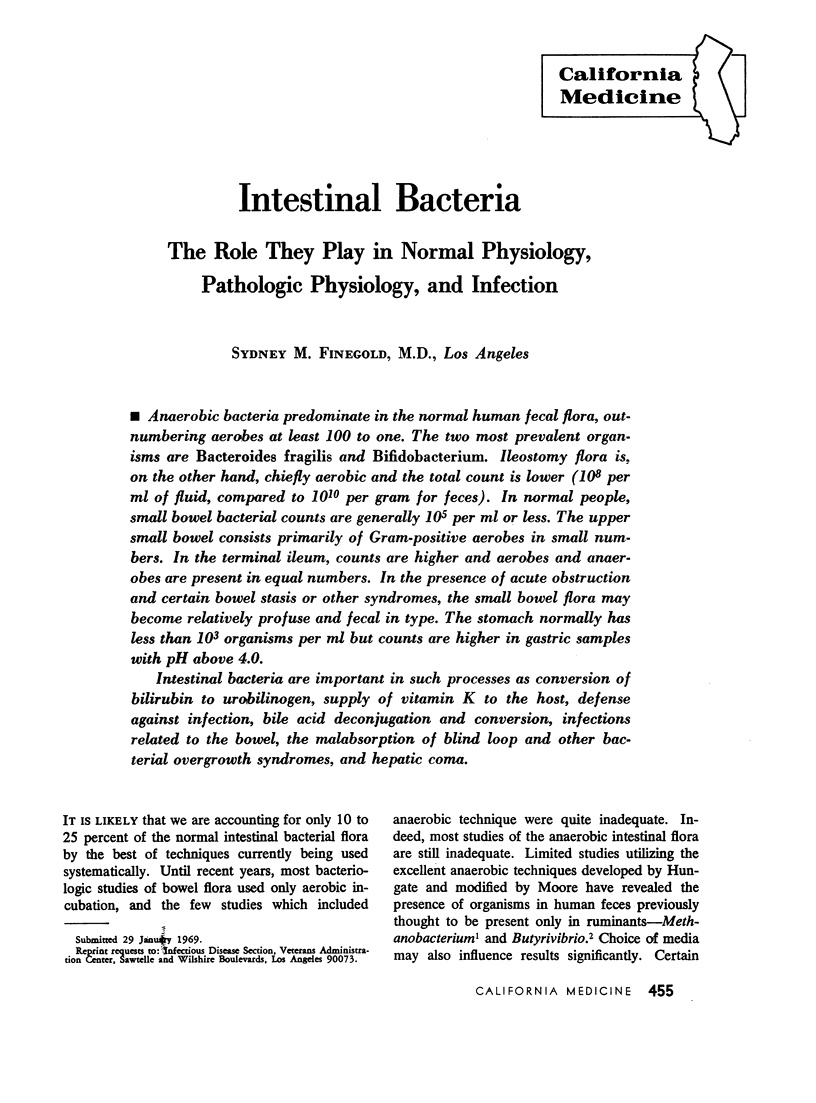
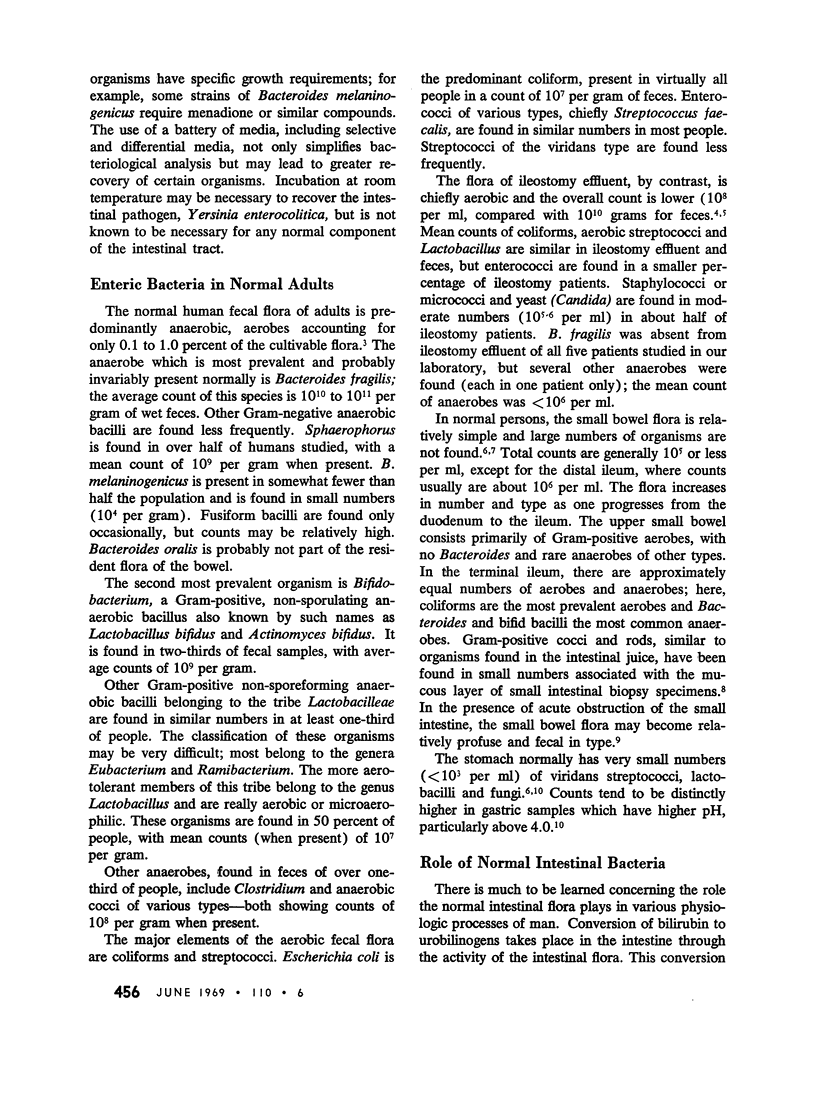
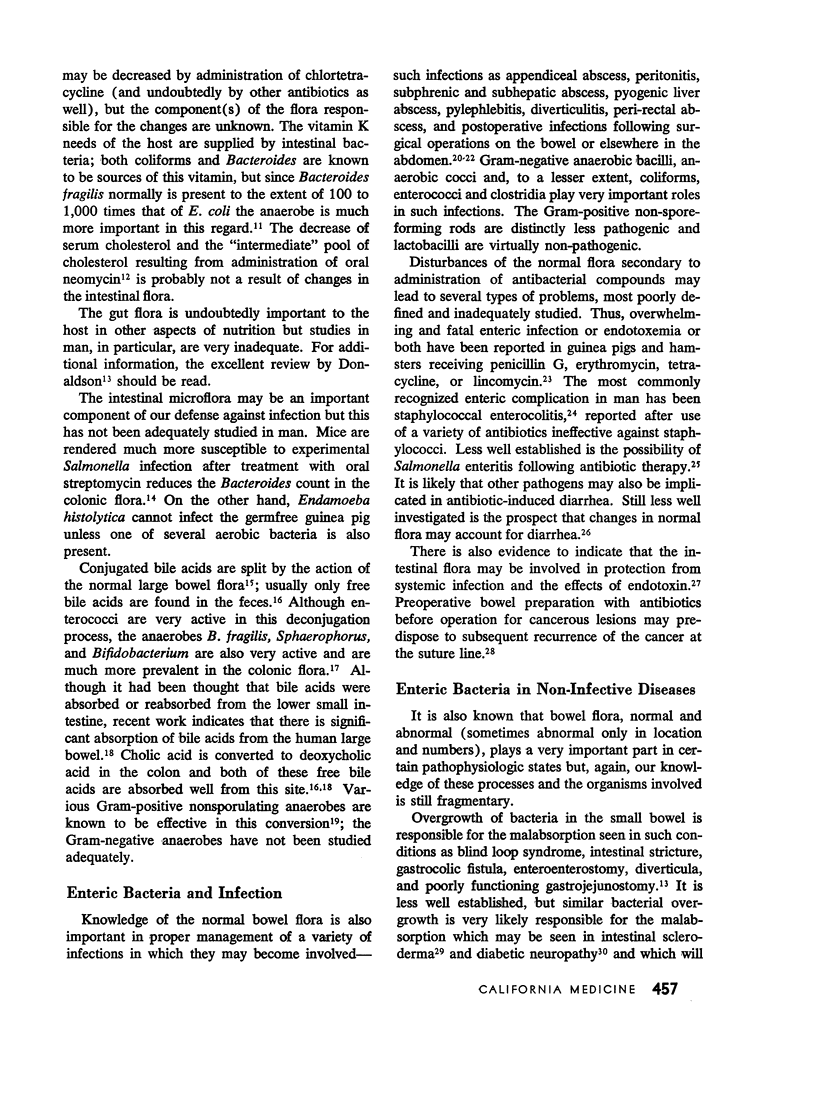
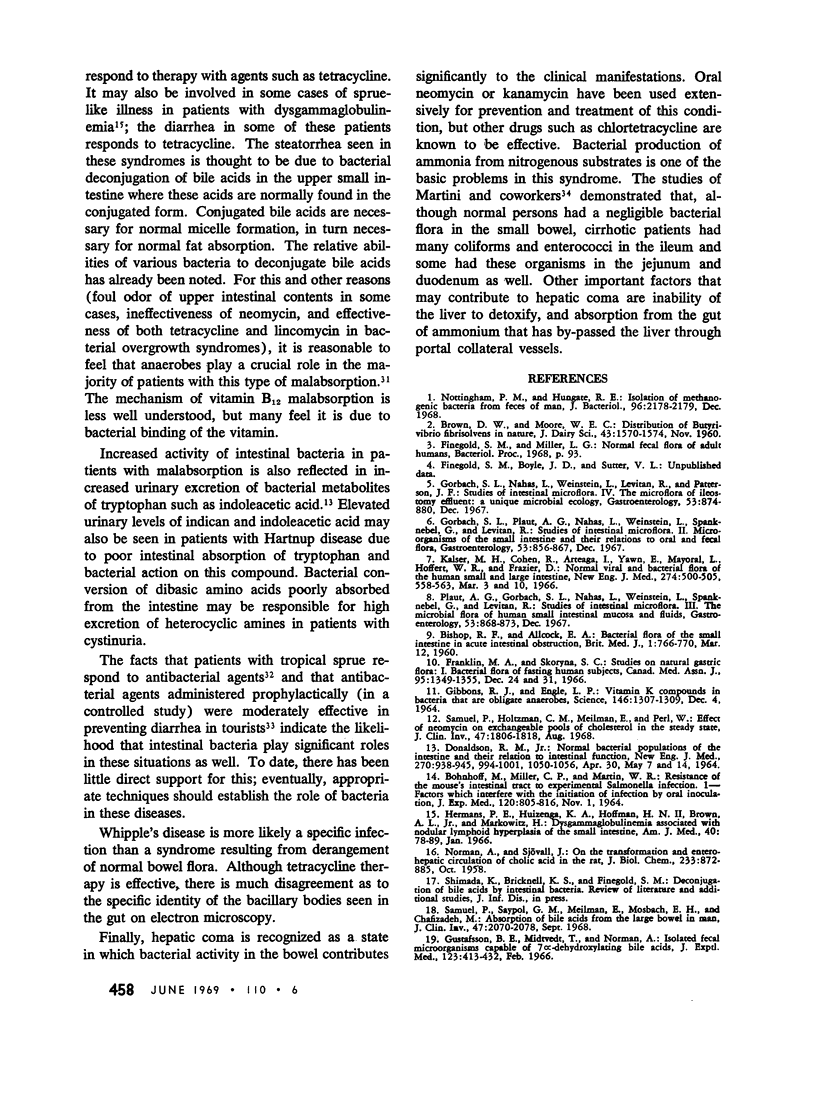
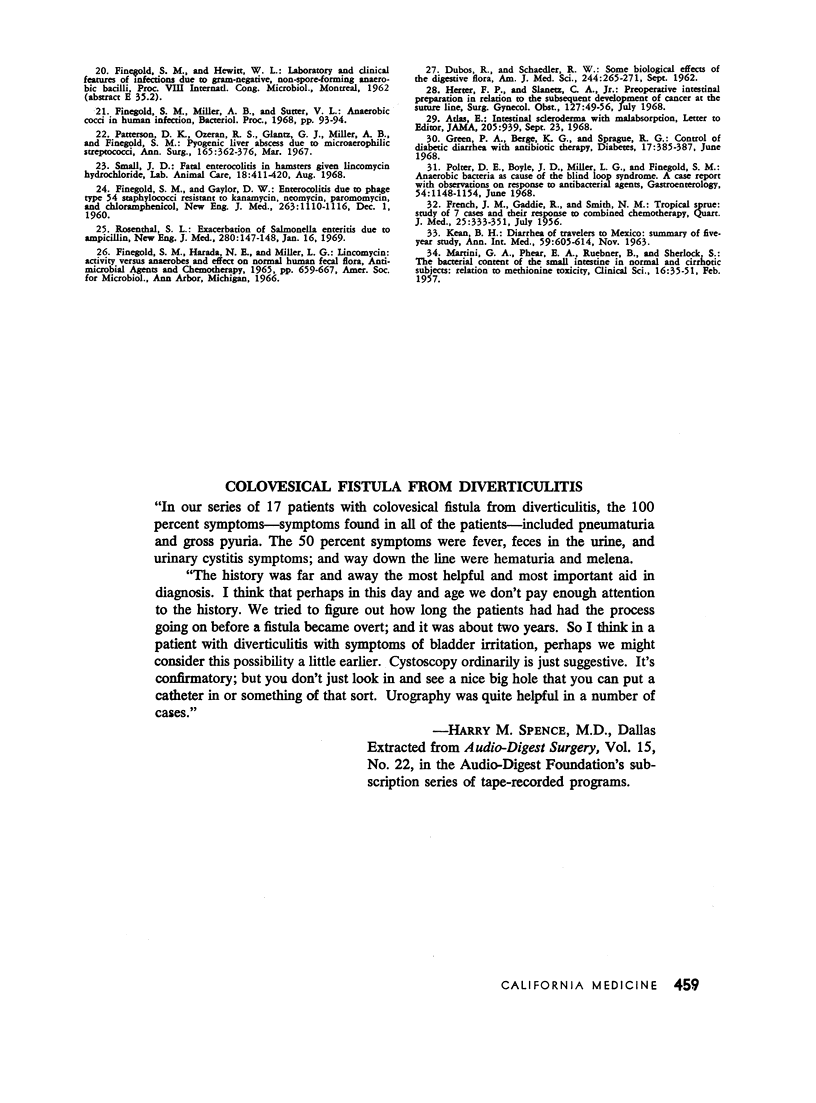
Selected References
These references are in PubMed. This may not be the complete list of references from this article.
- Atlas E. Intestinal scleroderma with malabsorption. JAMA. 1968 Sep 23;205(13):939–939. [PubMed] [Google Scholar]
- BISHOP R. F., ALLCOCK E. A. Bacterial flora of the small intestine in acute intestinal obstruction. Br Med J. 1960 Mar 12;1(5175):766–770. doi: 10.1136/bmj.1.5175.766. [DOI] [PMC free article] [PubMed] [Google Scholar]
- BOHNHOFF M., MILLER C. P., MARTIN W. R. RESISTANCE OF THE MOUSE'S INTESTINAL TRACT TO EXPERIMENTAL SALMONELLA INFECTION. I. FACTORS WHICH INTERFERE WITH THE INITIATION OF INFECTION BY ORAL INOCULATION. J Exp Med. 1964 Nov 1;120:805–816. doi: 10.1084/jem.120.5.805. [DOI] [PMC free article] [PubMed] [Google Scholar]
- DONALDSON R. M., Jr NORMAL BACTERIAL POPULATIONS OF THE INTESTINE AND THEIR RELATION TO INTESTINAL FUNCTION. N Engl J Med. 1964 May 14;270:1050–CONCL. doi: 10.1056/NEJM196405142702007. [DOI] [PubMed] [Google Scholar]
- DUBOS R., SCHAEDLER R. W. Some biological effects of the digestive flora. Am J Med Sci. 1962 Sep;244:265–271. doi: 10.1097/00000441-196209000-00001. [DOI] [PubMed] [Google Scholar]
- FINEGOLD S. M., GAYLOR D. W. Enterocolitis due to phage type 54 staphylococci resistant to kanamycin, neomycin, paromomycin and chloramphenicol. N Engl J Med. 1960 Dec 1;263:1110–1116. doi: 10.1056/NEJM196012012632204. [DOI] [PubMed] [Google Scholar]
- FRENCH J. M., GADDIE R., SMITH N. M. Tropical sprue; a study of seven cases and their response to combined chemotherapy. Q J Med. 1956 Jul;25(99):333–351. [PubMed] [Google Scholar]
- Finegold S. M., Harada N. E., Miller L. G. Lincomycin: activity against anaerobes and effect on normal human fecal flora. Antimicrob Agents Chemother (Bethesda) 1965;5:659–667. [PubMed] [Google Scholar]
- Franklin M. A., Skoryna S. C. Studies on natural gastric flora. I. Bacterial flora of fasting human subjects. Can Med Assoc J. 1966 Dec 24;95(26):1349–1355. [PMC free article] [PubMed] [Google Scholar]
- GIBBONS R. J., ENGLE L. P. VITAMIN K COMPOUNDS IN BACTERIA THAT ARE OBLIGATE ANAEROBES. Science. 1964 Dec 4;146(3649):1307–1309. doi: 10.1126/science.146.3649.1307. [DOI] [PubMed] [Google Scholar]
- Gorbach S. L., Nahas L., Weinstein L., Levitan R., Patterson J. F. Studies of intestinal microflora. IV. The microflora of ileostomy effluent: a unique microbial ecology. Gastroenterology. 1967 Dec;53(6):874–880. [PubMed] [Google Scholar]
- Gorbach S. L., Plaut A. G., Nahas L., Weinstein L., Spanknebel G., Levitan R. Studies of intestinal microflora. II. Microorganisms of the small intestine and their relations to oral and fecal flora. Gastroenterology. 1967 Dec;53(6):856–867. [PubMed] [Google Scholar]
- Green P. A., Berge K. G., Sprague R. G. Control of diabetic diarrhea with antibiotic therapy. Diabetes. 1968 Jun;17(6):385–387. doi: 10.2337/diab.17.6.385. [DOI] [PubMed] [Google Scholar]
- Gustafsson B. E., Midtvedt T., Norman A. Isolated fecal microorganisms capable of 7-alpha-dehydroxylating bile acids. J Exp Med. 1966 Feb 1;123(2):413–432. doi: 10.1084/jem.123.2.413. [DOI] [PMC free article] [PubMed] [Google Scholar]
- Hermans P. E., Huizenga K. A., Hoffman H. N., Brown A. L., Jr, Markowitz H. Dysgammaglobulinemia associated with nodular lymphoid hyperplasia of the small intestine. Am J Med. 1966 Jan;40(1):78–89. doi: 10.1016/0002-9343(66)90189-6. [DOI] [PubMed] [Google Scholar]
- Herter F. P., Slanetz C. A., Jr Preoperative intestinal preparation in relation to the subsequent development of cancer at the suture line. Surg Gynecol Obstet. 1968 Jul;127(1):49–56. [PubMed] [Google Scholar]
- KEAN B. H. THE DIARRHEA OF TRAVELERS TO MEXICO. SUMMARY OF FIVE-YEAR STUDY. Ann Intern Med. 1963 Nov;59:605–614. doi: 10.7326/0003-4819-59-5-605. [DOI] [PubMed] [Google Scholar]
- Kalser M. H., Cohen R., Arteaga I., Yawn E., Mayoral L., Hoffert W. R., Frazier D. Normal viral and bacterial flora of the human small and large intestine. N Engl J Med. 1966 Mar 3;274(9):500–contd. doi: 10.1056/NEJM196603032740907. [DOI] [PubMed] [Google Scholar]
- Kalser M. H., Cohen R., Arteaga I., Yawn E., Mayoral L., Hoffert W., Frazier D. Normal viral and bacterial flora of the human small and large intestine. N Engl J Med. 1966 Mar 10;274(10):558–contd. doi: 10.1056/NEJM196603102741006. [DOI] [PubMed] [Google Scholar]
- MARTINI G. A., PHEAR E. A., RUEBNER B., SHERLOCK S. The bacterial content of the small intestine in normal and cirrhotic subjects: relation to methionine toxicity. Clin Sci. 1957 Feb;16(1):35–51. [PubMed] [Google Scholar]
- Nottingham P. M., Hungate R. E. Isolation of methanogenic bacteria from feces of man. J Bacteriol. 1968 Dec;96(6):2178–2179. doi: 10.1128/jb.96.6.2178-2179.1968. [DOI] [PMC free article] [PubMed] [Google Scholar]
- Patterson D. K., Ozeran R. S., Glantz G. J., Miller A. B., Finegold S. M. Pyogenic liver abscess due to microaerophilic streptococci. Ann Surg. 1967 Mar;165(3):362–376. doi: 10.1097/00000658-196703000-00005. [DOI] [PMC free article] [PubMed] [Google Scholar]
- Plaut A. G., Gorbach S. L., Nahas L., Weinstein L., Spanknebel G., Levitan R. Studies of intestinal microflora. 3. The microbial flora of human small intestinal mucosa and fluids. Gastroenterology. 1967 Dec;53(6):868–873. [PubMed] [Google Scholar]
- Polter D. E., Boyle J. D., Miller L. G., Finegold S. M. Anaerobic bacteria as cause of the blind loop syndrome. A case report with observations on response to antibacterial agents. Gastroenterology. 1968 Jun;54(6):1148–1154. [PubMed] [Google Scholar]
- Rosenthal S. L. Exacerbation of salmonella enteritis due to ampicillin. N Engl J Med. 1969 Jan 16;280(3):147–148. doi: 10.1056/NEJM196901162800307. [DOI] [PubMed] [Google Scholar]
- Samuel P., Holtzman C. H., Meilman E., Perl W. Effect of neomycin on exchangeable pools of cholesterol in the steady state. J Clin Invest. 1968 Aug;47(8):1806–1818. doi: 10.1172/JCI105870. [DOI] [PMC free article] [PubMed] [Google Scholar]
- Small J. D. Fatal enterocolitis in hamsters given lincomycin hydrochloride. Lab Anim Care. 1968 Aug;18(4):411–420. [PubMed] [Google Scholar]


